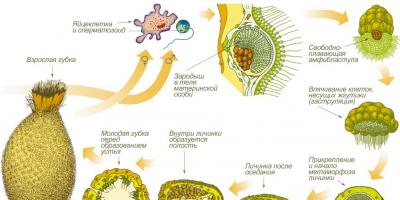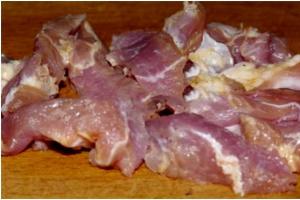Do gerberas grow only in gardens and greenhouses? No, beautiful orange or red inflorescences can also decorate the windows of a city apartment if you buy indoor varieties of the flower. Mini versions of the plant reach a height of 25–30 cm and produce one or more buds each year. Caring for an exotic gerbera is no more difficult than caring for an anthurium or orchid, and sometimes much easier.
Getting to know your new home
An adult plant is sold in specialized stores and even large supermarkets. I want to immediately give the purchased gerbera a drink with warm water and place it in the most visible place so that it becomes the main decoration of the house, but the flower must first adapt to the new place of residence.
For the first 3-4 days you should refrain from watering. The plant takes the necessary moisture from the soil, and an excess of water can cause rotting of the lower leaves or the appearance of fungus. Gerberas are transplanted only in two cases:
- when the soil is infested with pests;
- if the pot turns out to be too small and the root system peeks out of the ground.
You can transfer the flower to a new container 1.5–2 weeks after adaptation, when the plant gets used to it and gets stronger. Do not forget that spider mites or other insects sometimes live on gerberas brought from a nursery or supermarket. Pests are dangerous for other indoor plants, so the new resident is carefully inspected and isolated for about a week.
Light and temperature conditions
Gerbera produces buds in late August and delights with bright flowers until mid-late November. During this period, the room should be warm, within +25–20 degrees. If the thermometer shows +18–16, the plant goes into rest mode and the inflorescences fall off. At +14–12, the gerbera goes into hibernation. The flower cannot stay in a cool room for a long time. Low temperatures deplete the gerbera, and it begins to ache and wither. At the end of January, the exotic guest is transferred from warm room so that she has time to wake up and gain strength before the arrival of spring.On which windowsill should I place a pot of bright flowers? In summer, the east or west side is suitable. The plant will receive enough soft light and warmth. In winter, gerberas are moved to sunny southern windows, but northern ones are not suitable for growing an exotic beauty. They are too cold and shaded, so you will have to install phytolamps or regular table lamps to compensate for the lack of natural light.
In summer, gerberas need shade from the midday sun:
- move to a table next to the window;
- close the blinds so that diffused light falls on the windowsill;
- place under a tall, spreading tree if the plant is located outside.
Between May and September, the sun is hot enough to burn the plant's tender leaves, leaving unsightly yellow spots on the green surface. Daily contact with ultraviolet radiation is stressful for an exotic beauty, which can become seriously ill or completely wither.
At the same time, gerbera needs the sun, because without it it is not able to form buds and bloom. The plant feels comfortable when the daylight hours are from 10 to 12 hours. Therefore in winter exotic beauty and goes into hibernation mode, and in the spring it becomes active and begins to increase green mass.
The birthplace of the bright flower is considered to be the subtropics, where it is constantly warm and rainy. The plant loves water, but in moderation. In summer, gerbera is watered three times a week, in spring and autumn it is reduced to 2 times.

in winter tropical beauty can do without water long time. When the room is +12, the moisture becomes dangerous enemy gerberas, because the risk of fungal infection increases. In winter, the flower is watered as needed, when the upper and middle layers of the soil dry out.
Irrigation liquid should not be allowed to get into the leaf rosette or on the inflorescences. Droplets of water accumulate and create conditions for the development of fungus and root rot. It is difficult to get rid of diseases; gardeners have to change the soil and pot or throw away the gerbera if it cannot be treated.
Water intended for watering the exotic beauty is left to stand for 2–3 days. glass jars or plastic buckets. The liquid must be heated to +32–37 degrees. Carefully pour it into the soil or into a tray, from which the flower will take as much moisture as it needs. Do not allow water to stagnate at the bottom of the pot. Gerbera absorbs moisture in 30–40 minutes. The remaining liquid that turns out to be excess must be carefully drained. If this is not done, a fungus will grow in the pan, which will destroy the root system.
In summer it is useful to spray the green top with a spray bottle. In a similar way, moisturize and upper layer soil with a root system. Gerbera does not like dry air, because of which its leaves and inflorescences become pale and expressionless. To maintain an optimal level of humidity, it is recommended to place bowls or large mugs filled with water.
Tip: If the lower leaves of the gerbera begin to rot, you should reduce watering and stop spraying the plant. The soil is dry, but the problem persists? Either the flower has been damaged by rot or pests, or the water for irrigation needs to be more carefully filtered.
Mineral complexes
Gerbera does not tolerate organic matter. Fertilizers made from cow dung bird droppings or humus, will only harm the flower. Won't fit slaked lime, compost or wood ash. Only mineral complexes. We recommend universal varieties designed for any indoor flowers, or special options exclusively for exotic gerberas.
During the formation of buds, the plant is fed with nitrogenous compounds, which contain:
- ammonium sulfate;
- urea;
- Ammonium nitrate.
Classic version nitrogenous fertilizer - urea. Mineral fertilizing is applied 3-4 times a month, but after the inflorescences open, you should switch to complex options for indoor flowers. Such fertilizers are used in a similar way.
Crystals or powder should be dissolved in water for irrigation. The soil is pre-moistened so that the fertilizer does not burn the root system. Use only a weak solution; a concentrated solution can poison the gerbera.
Soil for an exotic plant
The tropical flower is constantly growing, and one day the pot becomes too small for its dense root system. We have to look for new house for gerbera and prepare a nutrient substrate. What should it be like?

The main thing is that the soil:
- let air through;
- was permeable;
- sterile;
- with a pH level of 5.5 to 6.
Gerbera, located in too acidic soil, does not absorb useful elements and dies.
There are several substrate options for growing exotic flowers:
- High-moor peat without additives. It is quite acidic and contains many useful components.
- Leaf soil with sand or moss, which is called sphagnum. Be sure to mix with peat or technical phosphoric acid to increase the pH of the substrate.
- Fine perlite is also suitable for growing gerbera, which allows the root system to breathe. High-moor peat is added to the synthetic base as a source of nutrients.
- Pine needles or coconut substrate can improve water permeability. Do not add compost or humus to the soil for gerberas.
If the soil has become too acidic due to peat, you should add a little chalk to it. Turf or leaf soil must be steamed to disinfect and destroy weed seeds. An alternative to heat treatment is pesticides. Solutions of formalin (5%) or carbation (2%) are recommended. The classic option for disinfecting soil is potassium permanganate. It is weaker than synthetic pesticides, so it is recommended to treat the soil with a concentrated solution of a dark pink or purple hue.
After disinfection, the soil is combined with peat and other components and infused for several days. During this time, beneficial bacteria and nutrients will appear in the soil.
An exotic plant must breathe, so the pot is chosen from ceramic or clay. A gerbera transplanted into a container that is too large spends energy and nutrients on the development of the root system, so the plant does not produce buds for 1–2 years. The flower feels cozy in a pot with a diameter of 25 cm and a depth of 30–35 cm. The upper part should be slightly wider than the bottom.

Cover the bottom of the container with a centimeter layer of drainage:
- crushed clay shards;
- broken bricks;
- pieces of polystyrene foam;
- fine expanded clay.
Fill the pot halfway with substrate. Remove the gerbera from the old container without separating the earthen lump from the root system. Transfer the flower to a new clay house. Place in the center and sprinkle with soil. Make sure that the root head remains on the surface of the ground. If a little substrate gets on the leaf rosette, carefully sweep it away with a brush or hand.
Gerberas are replanted in the spring before the first buds appear. You can transfer the plant to another pot after the flowers fade in July or November.
Reproduction
The exotic flower is grown from seeds. Prepare nutritious soil from turf soil, sand and peat, pour it into wooden box. Lay out the seeds, sprinkle with soil, moisten the substrate with a spray bottle and cover plastic film. Young shoots that are more than a month old are transplanted into separate pots.
Gerberas aged 4–5 years and older can be divided into several bushes.
- Remove the plant from the pot, do not clean it from the soil.
- Carefully divide into 2-3 parts. Each should have its own growth point.
- Shorten the roots a little and cut off the flowers. Treat open wounds with charcoal.
- Plant new bushes in pots with substrate.
All that remains is to water and fertilize the gerberas so that they grow faster and take root.
Diseases
- Spider mites appear due to insufficient watering and dry air. The flower must be sprayed with a spray bottle, adding any fungicide to the water.
- Aphids can attack a gerbera if it grows in the garden or stands on the balcony in the warm season. The insect is destroyed by insecticides that are used to treat the stems and leaves.
- White-winged flies appear in the summer due to the heat and dry air. The insecticide "Aktellik" will cope with pests.
- Gerbera affected by white or gray mold is isolated from other indoor flowers and treated with a solution copper sulfate. Remove damaged leaves and be sure to reduce watering.
Gerbera loves sunlight and warm water, humid climate and may die from drafts. The flower is not whimsical, but needs constant care and attention. If you protect the plant from insects and mold, fertilize it in a timely manner and remove dry leaves, the exotic beauty will become one of the main decorations of your apartment and a reason for pride.
Video: how to care for indoor gerbera
Gerbera is one of those plants that have rightfully earned the love of gardeners and florists. Large, daisy-like flowers, located on long leafless stems, can become a real decoration for your home. Of course, this can only be achieved if proper care of the gerbera is provided, in particular in winter.
If a plant grows in an apartment and you water it regularly, this does not mean that it does not need anything else. Therefore, in this article we will tell you how to grow gerbera in a pot so that it will delight you with its flowering for a long time.
Like many other house plants, gerbera requires proper care. temperature regime, lighting, irrigation and fertilizing systems.
Temperature and lighting
 "Transylvanian chamomile", and this is how gerbera is often called, is not a very heat-loving plant, so even in summer the most optimal temperature for it will be +20 - +22°C. In winter, temperatures should not exceed +16°C (this important condition when caring for gerbera after flowering). At the slightest discrepancy with these requirements, the plant may stop growing or flowering.
"Transylvanian chamomile", and this is how gerbera is often called, is not a very heat-loving plant, so even in summer the most optimal temperature for it will be +20 - +22°C. In winter, temperatures should not exceed +16°C (this important condition when caring for gerbera after flowering). At the slightest discrepancy with these requirements, the plant may stop growing or flowering.
Important! Transition from summer mode (flowering) to winter mode(rest) should occur smoothly. A sharp drop in temperature will have a detrimental effect on gerberas.
The plant prefers fresh and fresh air, so in summer you can easily take it out onto the balcony or into the courtyard of a private house. Just try to avoid drafts.
 As for lighting, indoor gerberas prefer bright sunlight when caring for them at home, so growing them on a windowsill is most preferable. However, in most cases, potted plants are placed on the west or east side, where they do not receive direct sunlight for part of the day. In winter, gerberas compensate for the lack of light with the help of fluorescent lamps, but abuse of lamps can lead to depletion of the flower, and then you will have to find out why the gerbera does not bloom.
As for lighting, indoor gerberas prefer bright sunlight when caring for them at home, so growing them on a windowsill is most preferable. However, in most cases, potted plants are placed on the west or east side, where they do not receive direct sunlight for part of the day. In winter, gerberas compensate for the lack of light with the help of fluorescent lamps, but abuse of lamps can lead to depletion of the flower, and then you will have to find out why the gerbera does not bloom.
Did you know? Despite the fact that gerbera is called Transylvanian chamomile, it came to us from South Africa.
Watering and fertilizing the soil
Watering gerberas should be moderate, but the soil should not be allowed to dry out. It is better to choose soft, settled water as the liquid used. room temperature(not boiled). Cold water has a detrimental effect on the plant, so such watering should be avoided.
 Water the gerbera at the edge of the pot and very carefully, avoiding liquid getting on the rosette. However, there is also Alternative option when water is poured into the pan, only in this case it will need to be drained after half an hour. Excessive moisture and stagnation of water in the pan can lead to the appearance of fungus and the formation of powdery mildew. If this happens, then you don’t have to ask why the leaves of your gerbera are turning yellow.
Water the gerbera at the edge of the pot and very carefully, avoiding liquid getting on the rosette. However, there is also Alternative option when water is poured into the pan, only in this case it will need to be drained after half an hour. Excessive moisture and stagnation of water in the pan can lead to the appearance of fungus and the formation of powdery mildew. If this happens, then you don’t have to ask why the leaves of your gerbera are turning yellow.
How often do you water gerberas? Watering is carried out evenly throughout the year. You can determine when a flower needs liquid by simply checking the soil (the soil should be slightly moist). In addition, spraying the leaves is not the least important. This procedure should be performed as often as possible.
Important! When spraying, try not to get it on the flowers, they don’t like it.
As for feeding a houseplant, it is recommended to do it 2-3 times a month, adding mineral fertilizers to the soil. True, most often this scheme is applied to young or recently transplanted plants. Adult gerberas feel great even if they are fertilized 1-2 times a year (nutrients allow the plant to bloom faster and protect it from diseases).
Replanting and soil composition for indoor gerbera
 Many gardeners replant indoor plants only if they become cramped in the pot, but this is not entirely correct. But how do you know when it is necessary to replant a gerbera? This is done regularly, approximately once a year, spring period. To successfully complete the procedure, you first need to choose the right new pot and prepare the soil. Optimal size The capacity for an adult plant is 1.5 liters; it is not recommended to take a larger pot. A little later, if the plant is completely healthy and nothing threatens its growth, you can simply periodically update the top layer of soil.
Many gardeners replant indoor plants only if they become cramped in the pot, but this is not entirely correct. But how do you know when it is necessary to replant a gerbera? This is done regularly, approximately once a year, spring period. To successfully complete the procedure, you first need to choose the right new pot and prepare the soil. Optimal size The capacity for an adult plant is 1.5 liters; it is not recommended to take a larger pot. A little later, if the plant is completely healthy and nothing threatens its growth, you can simply periodically update the top layer of soil.
For Transylvanian chamomile ideal option There will be a ceramic pot with drainage holes, because this is what can save a houseplant from overheating on hot summer days. However, your gerbera will be doubly grateful to you if you choose a breathable, lightweight substrate for the clay pot.
Soil can either be purchased from finished form, or make it yourself. Modern supermarkets sell really high-quality soil for indoor plants, but an increasing number of gardeners prefer to prepare it themselves.
There are several ways to prepare soil for gerbera:
- mix the same amount of peat and sand with two parts of leaf soil;
- take only clean high-moor peat;
- mix high-moor peat with soaked coke bark in a 2:1 ratio;
- add fine poured to the peat in a 1:1 ratio.
Important! Do not add to soil organic fertilizers, the Transylvanian rose does not like them.
 If the plant was only recently purchased in a store, replanting gerberas at home should not worry you yet. The flower needs to be given time to acclimatize in the house for several weeks, and only after that can it be transplanted into a new pot (the plant is removed from the previous container along with the lump old land on the roots).
If the plant was only recently purchased in a store, replanting gerberas at home should not worry you yet. The flower needs to be given time to acclimatize in the house for several weeks, and only after that can it be transplanted into a new pot (the plant is removed from the previous container along with the lump old land on the roots). Did you know? Some lovers of house plants do not understand why replant them after purchasing them, since the pot seems to be suitable and the soil is good. The fact is that in order to be marketable, growth stimulants must be included in the soil of sold plants, which allow them to maintain excellent appearance, while on display. However for further cultivation such land is unusable, so it needs to be replaced.
Reproduction of gerbera at home
Caring for gerberas after flowering is often accompanied by plant propagation. This procedure is performed in one of three ways: using seeds, dividing the mother bush or cuttings. In the last two cases, you need maximum concentration and accuracy, as there is a serious chance of damaging the plant or ruining its root system.
Seeds
 Gerbera seeds are sown in the spring (from March to May), placing them in a container with turfy, leafy soil, to which sand must be added. The seeds are sprinkled with earth half a centimeter on top, and after 3-4 leaves appear, the young shoots are cropped into separate pots. About 10 months pass from the moment of sowing to the start of flowering of the gerbera, so this method of plant propagation is not often chosen.
Gerbera seeds are sown in the spring (from March to May), placing them in a container with turfy, leafy soil, to which sand must be added. The seeds are sprinkled with earth half a centimeter on top, and after 3-4 leaves appear, the young shoots are cropped into separate pots. About 10 months pass from the moment of sowing to the start of flowering of the gerbera, so this method of plant propagation is not often chosen.
Dividing the bush
If you decide to propagate your gerbera by dividing the bush, then for these purposes it is better to select three- or four-year-old plants, leaving two or three growth points on each of them. Flowering occurs after the same time as in the first option.
 The sequence of division is as follows: The top layer of soil is carefully removed, exposing part of the rhizome, after which a shallow cut is made, which divides it into two parts. The cut area should be sprinkled with crushed coal and dry soil. After the gerbera has new roots (usually this happens after 3-4 weeks), it is carefully removed from the pot and, divided into two parts, planted in different containers.
The sequence of division is as follows: The top layer of soil is carefully removed, exposing part of the rhizome, after which a shallow cut is made, which divides it into two parts. The cut area should be sprinkled with crushed coal and dry soil. After the gerbera has new roots (usually this happens after 3-4 weeks), it is carefully removed from the pot and, divided into two parts, planted in different containers.
In most cases, this method is used for propagating valuable varieties, since when sowing purchased seeds it often turns out that the color in the picture and in reality are seriously different, and you have to wait a long time.
By cuttings
Another way to propagate gerbera is by cuttings. There is nothing complicated in the process itself, and all that is required of you is to cut off part of the stem with a leaf and plant it in a separate box with pre-heated soil (the temperature should not be lower than +20°C).
 It should be noted that this method is more difficult than all previous ones for carrying out in home (apartment) conditions. However, if you decide that it is the one that suits you best, then find a plant no older than three years old and take a part of its stem with a node and a leaf. Place them in moist soil and cover the box with oilcloth, leaving them for a week. During this time, new shoots should appear, and by planting them you will get new plants.
It should be noted that this method is more difficult than all previous ones for carrying out in home (apartment) conditions. However, if you decide that it is the one that suits you best, then find a plant no older than three years old and take a part of its stem with a node and a leaf. Place them in moist soil and cover the box with oilcloth, leaving them for a week. During this time, new shoots should appear, and by planting them you will get new plants.
The first scientific mention of the plant appeared in the works of the Dutch botanist E. Gronovius in 1737. They began to call this plant Gerbera in honor of the German doctor and botanist T. Gerber. The modern variety of gerberas appeared as a result of crossing two South African species - Jameson's gerbera and green-leaved gerbera. Gerbera is one of the most important floriculture crops, sold all over the world along with roses, carnations, chrysanthemums and tulips.
Gerbera is a light- and heat-loving plant that can only grow in hot countries in open ground.. In conditions middle zone can only be grown in greenhouse conditions. There are no domestic varieties in Russia, so gerbera has not yet taken its rightful place.
Features of the flower
Gerbera flowers are similar in shape to daisies (they are collected in basket-shaped buds, arranged singly and reach 0.04-0.15 m in diameter). Can be of various colors except of blue color. There are double and semi-double forms, differing in the number of “petals”, length and width.
Growing conditions at home
The seeds of these plants can easily be found on the shelves of flower shops.. But the plant is a perennial, and in our winter it will not overwinter either with or without shelter. This plant can be planted in a pot in the garden for the summer. And be sure to take it home for the winter, because the first frost will kill the foliage of this plant.
Gerbera is sold in flower shops already in pots in bloom. Having brought it home, over time you will notice that it loses its appearance and the leaves become faded. The reason is that gerbera is a very demanding plant to care for.
Conditions under which a gerbera will bloom and not die:
- Bright lighting. The plant must be grown on the south side. And in winter, in order for the gerbera to grow well, it needs additional lighting even on the south window.
- Nutritional value of the earth. As soon as they brought it from the store, it’s better to immediately put it in a larger pot. After two weeks, when the plant takes root, start feeding. They feed the plant with fertilizers for roses, they contain the most nutrients.
- Regular watering. The slightest drying of the substrate causes the leaves to wither and fall off.
- Constant inspection. Gerbera has very delicate leaves that insect pests love.
Watch a video about the features of caring for gerberas at home:
Reproduction methods
Watch a video about growing gerberas from seeds:
Division
 Lets do a large number of young plants from one adult. This has a beneficial effect on the adult gerbera, acquiring a second youth and continuing to grow and develop. The optimal age of a gerbera suitable for division is considered to be 4 years old.
Lets do a large number of young plants from one adult. This has a beneficial effect on the adult gerbera, acquiring a second youth and continuing to grow and develop. The optimal age of a gerbera suitable for division is considered to be 4 years old.
This procedure is carried out in the summer. When the plant has finished blooming, you must carefully remove it from flower pot, shake off the soil and divide into pieces using a knife.
Each piece should consist of a couple of leaves, part of an underground shoot and part of a root. Roots that are too long are trimmed, leaving 10-15 cm in length.
Cuttings
Used very rarely due to low efficiency. A part of the stem with a leaf is cut off and planted in a separate box with soil at a temperature of at least 20 degrees.
Planting and caring for flowers at home
The plant should be located in a sunny area. You can plant gerberas in absolutely any soil, the main thing is to first fertilize it with inorganic fertilizers. Water should not stagnate. Organic soils are not recommended for planting gerberas, as this plant is susceptible to fungal diseases, which often develop in organic fertilizers.
Compact varieties of gerberas are planted in the same way. room conditions. Only for growing it is recommended to use perlite or a slightly acidic substrate that is not susceptible to fungal diseases. In regular feeding mineral fertilizers plants growing in pure perlite need.
Gerberas grown in substrate require feeding every two weeks. There is no need to feed plants in winter. Watering should be done sparingly as the substrate dries. For irrigation, use only soft and settled water.
During active growth gerbera is watered abundantly, but not allowed to become waterlogged. Faded flowers are promptly removed to stimulate the growth of new flower stalks.
Advice: For the winter, the rhizome is dug up, sprinkled with sawdust or sand and stored in a dry place at a temperature of about 5-8 degrees throughout the winter, until spring.
Diseases and pests
The immunity of any plant drops if it is . This is the reason why pests attack it.

Read more about why gerbera leaves turn yellow and how to deal with it.
Compliance with all care conditions will help you grow a gerbera at home without any problems and admire it for a long time beautiful flowers on the windowsill or in the garden.
Nowadays, many garden flowers are grown in pots at home.
This is how gerberas are now placed on a saucer.
Indoor gerbera is a perennial. Its stems are up to 40-45 cm in height. The question that naturally arises is: how to care for it at home?
Types and varieties of indoor gerberas
Every modern variety is hybrid gerbera, which is bred from 2 species: classic green-leaved and Jameson.
Varieties that have compact and low stems are suitable for the windowsill, these are:
- Festival- in the photo you can see that it has a short stem, and even larger flowers that have a variety of shades.

- Aldebaran and Alcor- they have small flowers and narrow leaves.

- Jupiter, Vega, Migar- they have narrow leaves and medium-sized flowers.

- - This is a combination of many varieties with flowers of different shades.

Indoor gerbera: care at home
Growing a crop on a windowsill is quite simple, you just need to follow agricultural techniques, and you can grow a wide variety of varieties yourself.

The soil in which the plant is sold is not always suitable for its long-term cultivation, so the gardener is faced with the question of how to replant the gerbera after purchase.
It is not recommended to add compost or fresh humus to the substrate.
Holes for drainage should be made in the prepared container, pour expanded clay onto the bottom, and then soil from 2 parts of leaf soil, and 1 part each of peat soil and sand.
After replanting, water the plant generously along the edge of the pot, so as not to get it on the foliage. Water warm water. If water collects in the pan, drain it.
Lighting and temperature conditions
Gerbera in a pot prefers Sun rays and fresh air, because of this, the room where the flowers are located needs to be ventilated more often, but make sure that there is no draft wind blowing.

The temperature in the room in summer should be +16-20°C, and in winter, when the culture is at rest, then +12-14°C.
Gerbera naturally grows in the tropics, so she tolerates heat more easily than cold. In winter, a pot with a plant can be placed on a glazed loggia with an air temperature of +12-14°C, but for a short time. It is not recommended to radically change the temperature, as this reduces the flower’s resistance.
Watering
 Home gerbera loves water, water it often, but not too much, as the rhizomes may begin to rot.
Home gerbera loves water, water it often, but not too much, as the rhizomes may begin to rot.
Water, being careful not to get it on the leaves.
But it's even better if you pour the water into the pan, and drain the excess from it after a few minutes after the gerbera absorbs moisture. Water for irrigation should have a temperature of +20°C. In winter, water the crop less often.
Air humidity
Because You cannot spray the crop from a spray bottle., because moisture should not get on the leaves, you can purchase an air humidifier. It is also good to place wide basins of water near the gerbera. Or you can pour wet pebbles into the tray.
Fertilizer application
Organic matter cannot be added. Therefore, buy fertilizer Forte, Biosad or others. From April to August, the crop is fed once every 3 weeks. When the buds open, the crop is fed with a composition that has large amount of potassium.
And during rest - mixture with a lot of nitrogen. The fertilizer is heavily diluted with water to obtain a weakly concentrated solution.
Transplantation and soil requirements
The plant is replanted in autumn or winter. For transplantation, choose a container that is 2-3 cm larger in diameter.

If you decide to make the substrate yourself, then mix sand, humus, peat and turf soil in equal parts, add 2 parts of leaf soil and a little perlite.
Diseases and pests
Do not overwater the plant, otherwise the rhizomes will rot, and then the leaves and stem will begin to rot.
The plant may get gray rot. At the same time, a grayish coating is visible on the base of the foliage, peduncles, and flowers, and gradually the entire gerbera fades. If you find gray rot, then spray the plant with Fundazol, Rovral.
It may appear on young flowers powdery mildew. When the disease occurs, a whitish coating is noticeable on the petioles of the foliage. Then the plaque spreads to flowers, buds, and eventually the plant dies.
Attention! With excessive watering, the crop may become infected with late blight. If the air is too dry, the flower may appear spider mite.
To cure a plant from diseases, spray it with Topaz or Fundazol.
Main problems when growing
Why do the leaves turn yellow?
 With Alternaria blight, brownish spots are visible on the foliage.
With Alternaria blight, brownish spots are visible on the foliage.
Then the leaves begin to turn pale and turn yellow.
Also, with mosaic, yellowish-green spots appear, and then leaf necrosis develops.
It is best to treat gerbera with Radomil Gold.
In this video once again about how to properly care for indoor gerbera:
How to achieve lush flowering
Despite its love for bright sun, the plant stops blooming if there is too much light. Gerbera needs no more than 12 hours of daylight. It blooms most luxuriantly from late August to November.

If a gerbera does not bloom for more than 3 months, this means that the reason is not the light, but something else. A plant may stop forming buds if it is planted in a pot that is too large for it, then the crop directs all its energy to the growth of rhizomes. If you put nitrogen under the gerbera, it will also stop flowering.
Reproduction of gerbera at home
Gerbera can be propagated by seeds, dividing the bush and cuttings.
Propagation by seeds
When you buy seeds, read the expiration date on the bag. The seeds remain viable for 8 months from the time of collection. It is best to sow in spring.
Step-by-step sowing instructions:

Reproduction by dividing the bush
Choose a bush that is 3-4 years old. The plant should grow to several bushes. Separate one.
Plant it in a container, and in six months it will grow a rhizome.
Reproduction by cuttings
 Choose a young plant that is not yet 3 years old.
Choose a young plant that is not yet 3 years old.
Cut off the part of its stem that has a leaf and a node. Plant the cuttings in warm and moist soil and cover with film. Don't forget to water. Within a week, new shoots will grow. Then transplant the crop into a new pot.
If you follow the correct agricultural practices when caring for the plant, it will bloom luxuriantly and not get sick. Don't water the flower too much, but do it often.

IN Lately many garden flowers have moved into the home and are successfully grown in a pot. So the bright gerbera, not at all a capricious beauty, pleases the eyes of gardeners, standing on the windowsill.
Gerbera is a flower of the Asteraceae family, which belongs to perennial plants. This flower is well suited for growing not only in the garden, but also at home.
Not at all complicated home care for indoor gerbera. The height of this plant grown at home reaches 40-45 cm.
How to grow such a miracle on your windowsill? Is it possible to grow in winter time of the year?
Types of gerbera with photos
At home and with proper care, indoor gerberas can bloom several times a year. All presented flowers, which are grown on plots and at home, were the result of selection of two varieties: classic green leaf and Jameson. And within these species, varieties and varieties are divided by color, flower size, doubleness.
Suitable for growing on a windowsill low-growing and compact species, which include the following varieties:
Festival - characterized by a short stem and large multi-colored flowers. 
Aldebaran and Alcor - have small flowers and narrow leaves, often used for industrial cultivation. 
Jupiter, Vega, Migar– the flowers have narrow leaves, and the flowers are slightly larger. 
Mars – This variety has medium-sized leaves and large flowers. 
Gerbera Mix is especially popular among gardeners, not only because of its beauty, but also because of its varied colors. It does not reach large sizes when grown in pots, and also does not require special care.
How a gerbera wakes up and falls asleep, video:
Growing gerbera from seeds
When purchasing gerbera seeds, you need to pay attention to the expiration date. They remain viable for up to 8 months from the moment of collection, so the grower should not miss this moment.
The optimal time for sowing seeds is spring, but if artificial lighting is possible, then sowing can be done at any time.
Sowing of seeds occurs in the following sequence:

Indoor gerbera begins to bloom only after 9-11 months after disembarkation and subject to proper care. If you make minor mistakes in care or replanting, you can significantly delay the flowering period.
How to care for gerbera in a pot?
Growing gerbera daisies in a pot is not difficult. Compliance with certain rules and principles allows you to create a whole greenhouse of gerberas on the windowsill.

Features of care
Gerbera, like any home plant, loves care and concern. It is important to know how to do this, and the following important aspects are highlighted here:
Proper care of indoor gerberas promotes regular flowering and disease prevention. You should not be overzealous with watering, spraying and fertilizing.

Care for gerbera at home
There are tips and suggestions from experts on how to care for your home gerbera, which can ensure proper growth and flowering for the flower.
So, here we can highlight the following aspects:

Gerbera gerberas should only be transplanted into another pot when they are at rest. You should select a pot larger than the previous one by 2-3 cm in diameter.

Gerbera propagation
The flower can be grown not only from seeds, but also by dividing the bush. From a lush gerbera bush, which is 3-4 years old, it is necessary to separate a bush, of which by this time it should have formed several.
Plant the separated seedling in a pot, where it will develop and take root within six months. Flowers on a new bush will appear only after 10-11 months.

Pests and diseases of gerbera
The presented plant is very resistant to disease, but, no matter what, it is necessary to follow the watering regime. The roots should not be flooded, otherwise they will begin to rot, and the rot will spread to the stem and leaves.
The most dangerous fungal diseases gerberas:

Dry air can also harm the flower - it can wither and dry out. In addition, it can provoke an infestation of spider mites, which can be eliminated by treating with fungicides. Excessive watering of the plant can lead to late blight infection.
Gerbera care, video:
Garden gerbera: planting and care
Gerbera loves warm, mild climates. Growing this in the garden bright flower, remember that in cold weather it simply will not bloom.
Choosing a variety for growing in open ground
To achieve bright and regular flowering, it is important to choose the right flower variety. The following varieties are suitable for growing in open ground:

Each variety has its own requirements for growing conditions and care, so it is recommended to study the full information before purchasing.
Planting gerberas
There are three ways to plant gerbera in the garden: seeds, seedlings and cuttings.
Planting by cuttings requires preparation. To do this, you need to dig up a gerbera bush, wash the rhizomes and cut off the leaf rosettes.
Plant the rhizome in a greenhouse, and after two weeks sprouts from the axillary buds will begin to appear. These are the cuttings, which after some time can be planted in the ground.
You can grow seedlings from seeds only in closed ground. It is necessary to start sowing based on the fact that the gerbera will begin to bloom no earlier than 10-11 months later.
In prepared soil, pre-treated with a solution of potassium permanganate, and also optimally moistened, seeds should be planted, slightly deeper into the soil, and sprinkled with peat. Cover the bed with glass or film.
It is important to ventilate and moisten the soil every day, since seeds will only germinate in moist soil. After 8-10 days, shoots will appear.
IN open ground Plant when the weather is consistently warm and free of frost. The sprouts themselves should grow to an acceptable size - have several pairs of leaves.

Features of growing gerberas in open ground
For growing gerbera in the garden you need to choose a sunny place. When planting cuttings in the soil, do not deepen the stem, otherwise the root may rot. Seedlings must be watered regularly and abundantly.
Gerberas bloom for 4 months, which means that the garden will be bright and sunny all summer. It is necessary to water the flowers in the area with warm water, avoiding getting it on the flowers. Once every two weeks the plant should be fed with mineral fertilizers.
Pay attention to this material -
For the winter, gerberas are dug up and put in a room where the temperature does not fall below +7 degrees. At this time, it also needs to be watered and ventilated.

Since gerbera is a perennial plant, in the fall it can be left on the site, but covered with a thick layer of leaves or straw. In areas with colder climates, the bushes can be grown as an annual plant.
Diseases in garden gerbera the same as at home, and processing methods are similar. Pests of plants planted in open ground: spider mites, thrips and aphids.
By attacking the gerbera, they cause it to wilt, yellowing of the leaves and even the death of the bush. Having recognized the pest in time, the plant should be treated with insecticides.
Gerbera is a very beautiful and bright flower that pleases the eye and improves mood. By planting seedlings in time and caring for them properly, you can grow healthy and flowering plant. Gerbera symbolizes modesty and tenderness, so give flowers to your loved ones as a sign of great respect and admiration.










